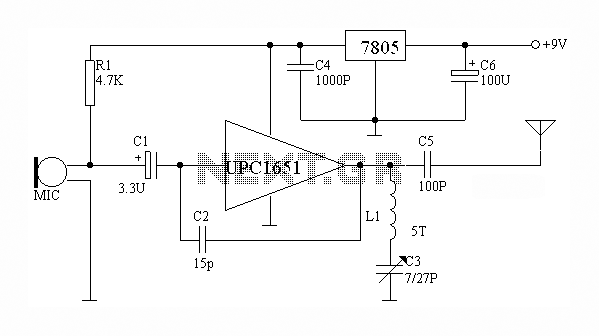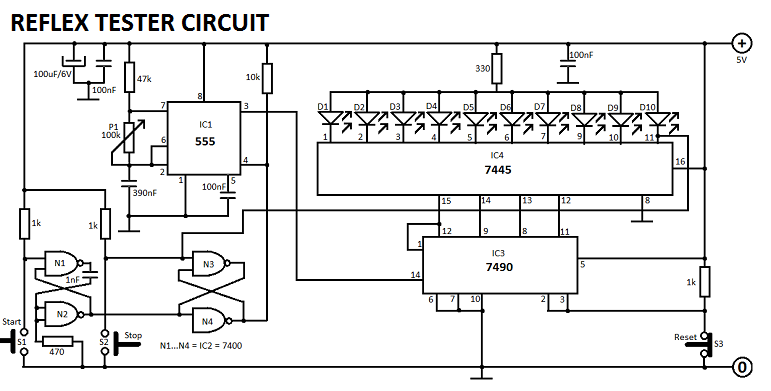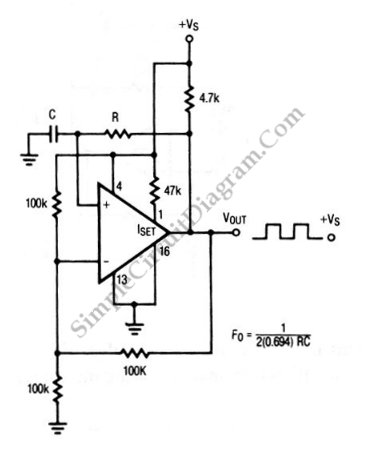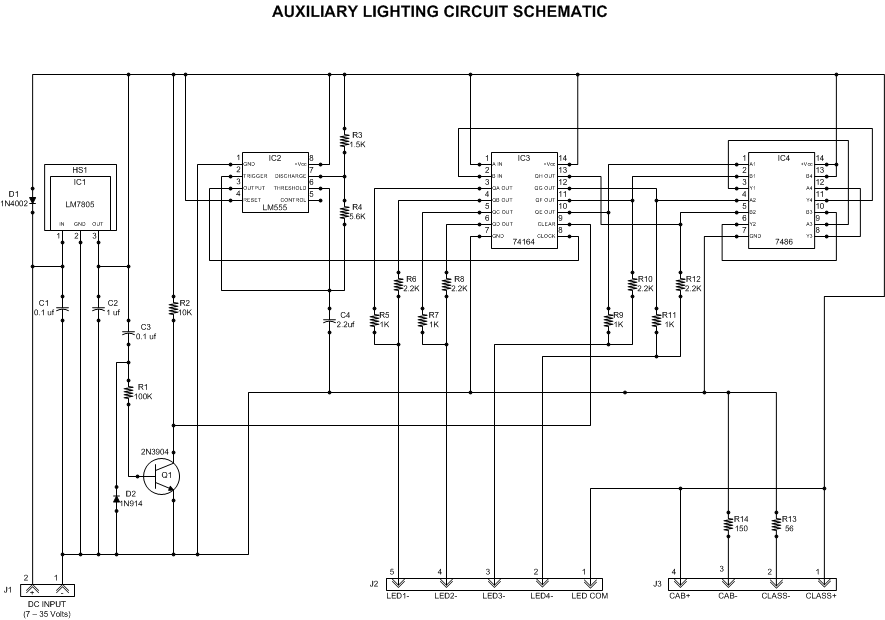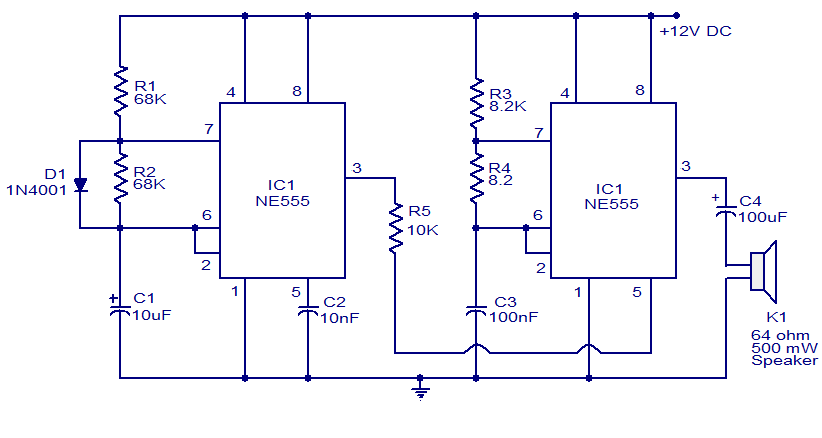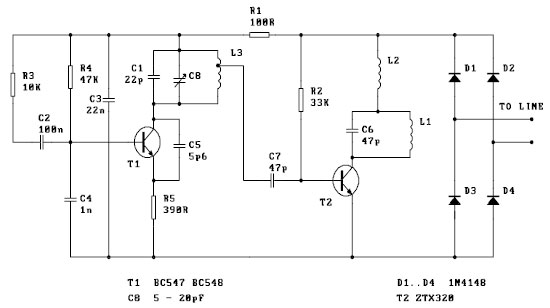
Microphone Circuit Test Oscillator

This circuit is designed to be housed in a compact plastic or preferably metal enclosure, powered by a 9V battery. It features a level control, a male XLR connector (similar to those used in microphones), and a switch. The current draw is minimal due to the use of a single dual op-amp, specifically the 1458, which suffices for this application. The primary function of the circuit is as an oscillator, utilizing a simple three-stage phase shift oscillator configuration, which is not commonly seen in other applications. This circuit was originally designed for a separate project and has not been widely documented in op-amp application notes, suggesting it may be a novel design. For tuning purposes, a 50k potentiometer can be used in place of resistor R1, with a recommendation to set the frequency to A-440 Hz. Frequency stability is moderate, with variations of a few Hertz as the battery discharges; however, this is acceptable as the circuit serves as a test oscillator rather than a tuning standard. The expected frequency output is approximately 430Hz, contingent on the accuracy of the capacitors used. The phase shift network, consisting of R1-C1, R2-C2, and R3-C3, performs two key functions: it shifts the output signal's phase to enable positive feedback for oscillation, and it acts as a three-stage filter to attenuate the signal, resulting in a reasonable sine wave output at pin 2. The distortion level is around 3%, based on previous measurements. The second stage provides an output buffer, splitting the signal to feed the two microphone leads. The metal enclosure should be grounded to pin 1 (earth) of the XLR connector. The output level control must be a linear type, as circuit loading will approximate a logarithmic potentiometer. The maximum output into a standard microphone input is approximately 100mV, with an unloaded oscillator output measured at 140mV. The entire circuit can be constructed on a small piece of ferro board, with the battery, potentiometer, and XLR connector occupying more space than the oscillator itself. An LED power indicator is omitted to conserve current, and a slide switch is recommended to prevent accidental activation, despite being more challenging to mount than a toggle switch. If a potentiometer with an integrated switch is available, it would be an optimal solution, although such components are becoming increasingly rare, particularly in linear configurations.
The circuit operates primarily with a dual op-amp, the 1458, which is well-suited for low-power applications. The three-stage phase shift oscillator utilizes resistors and capacitors to create the necessary phase shifts, facilitating stable oscillation. The design allows for a tunable frequency, which can be adjusted using a potentiometer, enhancing flexibility for applications requiring specific frequency outputs. The output stage is designed to buffer the oscillator's signal, ensuring that it can drive microphone inputs effectively without significant signal loss. The grounding of the metal enclosure is critical for minimizing noise and ensuring signal integrity, particularly in audio applications. Additionally, the choice of a linear potentiometer for output level control is essential, as it provides a more accurate representation of the signal level to the user. Overall, the simplicity of the design allows for easy assembly and integration into various audio testing setups, making it a practical choice for engineers and hobbyists alike.This circuit would be mounted in a small plastic or preferably metal box, with a 9V battery, level control, a male XLR connector (same as on a microphone) and a switch. Current drain is low, since the circuit only uses one dual op amp. There is no need for a high quality device, and a 1458 is all that is needed. The first stage is the oscillator i tself. This is a simple three stage phase shift oscillator - a circuit that is remarkably uncommon - which is to say I have never seen it used elsewhere. I designed it for another project a few years ago, and I dont understand why it is not in any op amp application notes.
Maybe I invented a new circuit. If you want to tune it, you can use a 50k pot instead of R1. I suggest that if tuned, set it to A-440 Hz. Frequency stability is not wonderful, and it changes by a few Hertz as the battery discharges, but this is unlikely to cause problems - it is a test oscillator, not a tuning standard. As shown, frequency will be about 430Hz, depending on the accuracy of the capacitors. The phase shift network (R1-C1, R2-C2 and R3-C3) serves two purposes. First (and for an oscillator, most importantly), it shifts the phase of the output signal so the feedback is positive, causing oscillation.
Secondly, since it is a three stage filter, it attenuates the signal and filters the output square wave so the signal at pin 2 is a reasonable sine wave. Distortion (if you really care) is about 3% or so - I didnt measure it this time, but I recall having done so before.
The second stage is the output buffer, and the signal is simply split to supply the two mic leads. The metal case should be connected to pin 1 (earth) on the XLR connector. The output level control must be a linear type, as the circuit loading will create a good approximation to a log pot. Maximum output into a typical microphone input will be about 100mV (unloaded oscillator output on mine was 140mV).
It is not much to it - the whole circuit can be built on a small piece of ferro board, and the battery, pot and XLR connector will take up far more room than the oscillator. There is no LED indicator for power, as this would draw more current than the circuit. To prevent accidentally turning it on, a slide switch is suggested. They are a pig to mount compared to a toggle switch, but are much less easily bumped. If you can get a pot with a switch, this would be even better, but these are now hard to get - especially as linear.
🔗 External reference
The circuit operates primarily with a dual op-amp, the 1458, which is well-suited for low-power applications. The three-stage phase shift oscillator utilizes resistors and capacitors to create the necessary phase shifts, facilitating stable oscillation. The design allows for a tunable frequency, which can be adjusted using a potentiometer, enhancing flexibility for applications requiring specific frequency outputs. The output stage is designed to buffer the oscillator's signal, ensuring that it can drive microphone inputs effectively without significant signal loss. The grounding of the metal enclosure is critical for minimizing noise and ensuring signal integrity, particularly in audio applications. Additionally, the choice of a linear potentiometer for output level control is essential, as it provides a more accurate representation of the signal level to the user. Overall, the simplicity of the design allows for easy assembly and integration into various audio testing setups, making it a practical choice for engineers and hobbyists alike.This circuit would be mounted in a small plastic or preferably metal box, with a 9V battery, level control, a male XLR connector (same as on a microphone) and a switch. Current drain is low, since the circuit only uses one dual op amp. There is no need for a high quality device, and a 1458 is all that is needed. The first stage is the oscillator i tself. This is a simple three stage phase shift oscillator - a circuit that is remarkably uncommon - which is to say I have never seen it used elsewhere. I designed it for another project a few years ago, and I dont understand why it is not in any op amp application notes.
Maybe I invented a new circuit. If you want to tune it, you can use a 50k pot instead of R1. I suggest that if tuned, set it to A-440 Hz. Frequency stability is not wonderful, and it changes by a few Hertz as the battery discharges, but this is unlikely to cause problems - it is a test oscillator, not a tuning standard. As shown, frequency will be about 430Hz, depending on the accuracy of the capacitors. The phase shift network (R1-C1, R2-C2 and R3-C3) serves two purposes. First (and for an oscillator, most importantly), it shifts the phase of the output signal so the feedback is positive, causing oscillation.
Secondly, since it is a three stage filter, it attenuates the signal and filters the output square wave so the signal at pin 2 is a reasonable sine wave. Distortion (if you really care) is about 3% or so - I didnt measure it this time, but I recall having done so before.
The second stage is the output buffer, and the signal is simply split to supply the two mic leads. The metal case should be connected to pin 1 (earth) on the XLR connector. The output level control must be a linear type, as the circuit loading will create a good approximation to a log pot. Maximum output into a typical microphone input will be about 100mV (unloaded oscillator output on mine was 140mV).
It is not much to it - the whole circuit can be built on a small piece of ferro board, and the battery, pot and XLR connector will take up far more room than the oscillator. There is no LED indicator for power, as this would draw more current than the circuit. To prevent accidentally turning it on, a slide switch is suggested. They are a pig to mount compared to a toggle switch, but are much less easily bumped. If you can get a pot with a switch, this would be even better, but these are now hard to get - especially as linear.
🔗 External reference
Warning: include(partials/cookie-banner.php): Failed to open stream: Permission denied in /var/www/html/nextgr/view-circuit.php on line 713
Warning: include(): Failed opening 'partials/cookie-banner.php' for inclusion (include_path='.:/usr/share/php') in /var/www/html/nextgr/view-circuit.php on line 713
